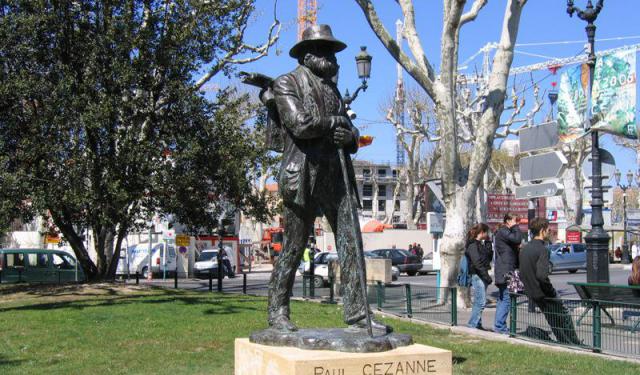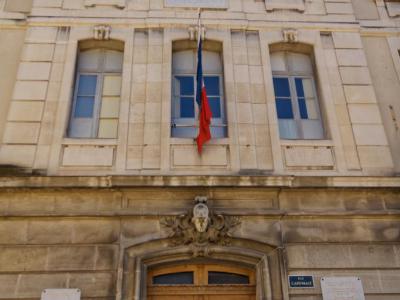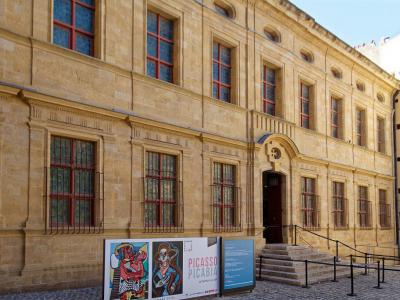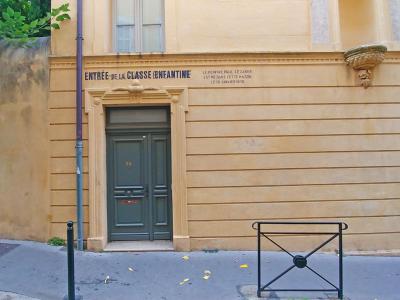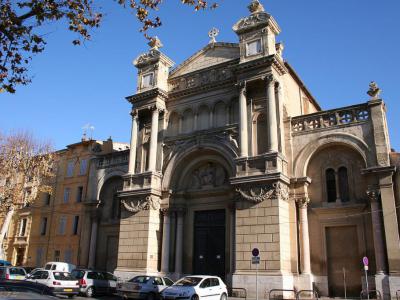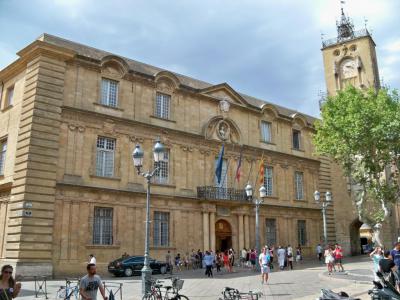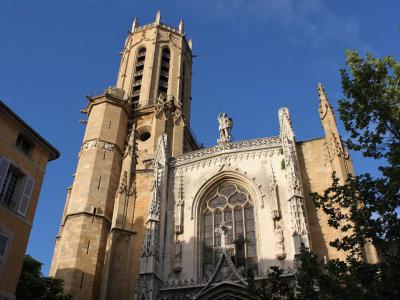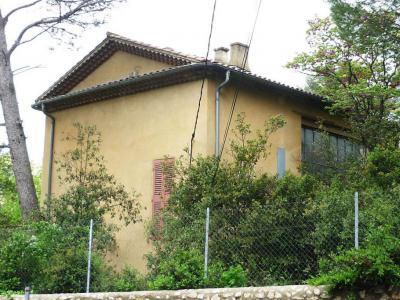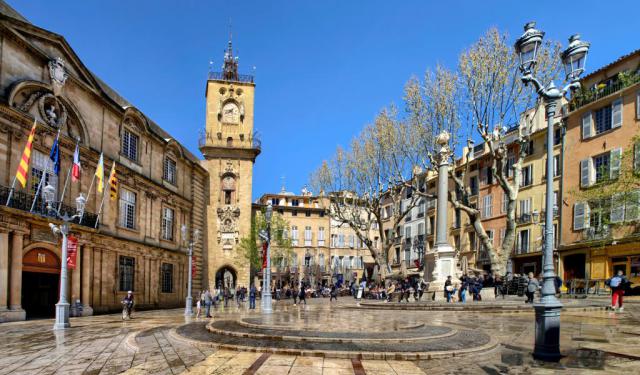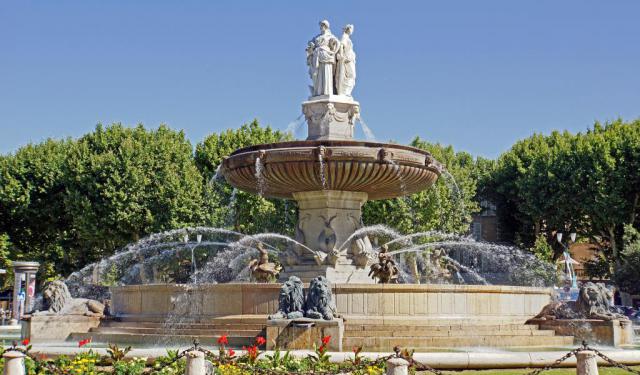Audio Guide: In the Footsteps of Paul Cézanne (Self Guided), Aix-en-Provence
Paul Cézanne, often called the “father of modern art” for bridging 19th-century post-impressionism and the birth of early modernism, caused a bit of a stir early in his career. While staying with Doctor Gachet in Auvers-sur-Oise, he painted his take on Manet’s Olympia-but with a twist. Instead of just a reclining nude, Cézanne inserted himself into the scene, back turned, like a shy admirer interrupting a muse. At the time, Paris wasn’t impressed. His banker father wasn’t either-he’d hoped Paul might choose deposits over brushstrokes.
But Cézanne stayed loyal to his muse. Born in Aix-en-Provence in 1839, he entered Saint Joseph School at ten, then moved on to Collège Bourbon-now Collège Mignet-where he befriended Émile Zola and Baptistin Baille. The three were inseparable: a future novelist, a scientist, and a painter with a knack for rebellion. Cézanne also studied drawing at the Municipal School and the School of Design at the Granet Museum, sharpening his skills in between existential doubt and watercolor sessions.
The house where he was born still stands at 28 Opera street. You can’t go inside, but a modest plaque gives a respectful nod. His second childhood home on Matheron street is nearby, and his final address at 23 Boulegon street leads up to his cherished studio on Lauves Hill. That studio is frozen in time: brushes still out, canvases still waiting, and the light still exactly as he liked it.
The trail through Aix is marked with brass plaques in the pavement-Cézanne’s unofficial breadcrumb trail. You’ll pass his statue near the Fountain of the Rotunda, looking calm, possibly smug, now that the city’s caught up to his genius. Keep going and you’ll reach Aix Cathedral, a patchwork of Romanesque, Gothic, and Baroque architecture that Cézanne often painted from the outside but rarely ventured into.
Other meaningful stops include the Church of the Madeleine, where he was baptized; the Town Hall, where he married Hortense Fiquet; and his longtime family home at Jas de Bouffan.
Cézanne passed away in 1906. He’s buried at Saint-Pierre Cemetery, where quiet visitors still come to pay respects-not just to a painter, but to a stubborn, brilliant force who never really left Aix.
So while looking for Cézanne's footsteps, pause where he paused. Let the rooftops, the orchards, and the light do what they’ve always done-give inspiration to those paying attention.
But Cézanne stayed loyal to his muse. Born in Aix-en-Provence in 1839, he entered Saint Joseph School at ten, then moved on to Collège Bourbon-now Collège Mignet-where he befriended Émile Zola and Baptistin Baille. The three were inseparable: a future novelist, a scientist, and a painter with a knack for rebellion. Cézanne also studied drawing at the Municipal School and the School of Design at the Granet Museum, sharpening his skills in between existential doubt and watercolor sessions.
The house where he was born still stands at 28 Opera street. You can’t go inside, but a modest plaque gives a respectful nod. His second childhood home on Matheron street is nearby, and his final address at 23 Boulegon street leads up to his cherished studio on Lauves Hill. That studio is frozen in time: brushes still out, canvases still waiting, and the light still exactly as he liked it.
The trail through Aix is marked with brass plaques in the pavement-Cézanne’s unofficial breadcrumb trail. You’ll pass his statue near the Fountain of the Rotunda, looking calm, possibly smug, now that the city’s caught up to his genius. Keep going and you’ll reach Aix Cathedral, a patchwork of Romanesque, Gothic, and Baroque architecture that Cézanne often painted from the outside but rarely ventured into.
Other meaningful stops include the Church of the Madeleine, where he was baptized; the Town Hall, where he married Hortense Fiquet; and his longtime family home at Jas de Bouffan.
Cézanne passed away in 1906. He’s buried at Saint-Pierre Cemetery, where quiet visitors still come to pay respects-not just to a painter, but to a stubborn, brilliant force who never really left Aix.
So while looking for Cézanne's footsteps, pause where he paused. Let the rooftops, the orchards, and the light do what they’ve always done-give inspiration to those paying attention.
How it works: Download the app "GPSmyCity: Walks in 1K+ Cities" from Apple App Store or Google Play Store to your mobile phone or tablet. The app turns your mobile device into a personal tour guide and its built-in GPS navigation functions guide you from one tour stop to next. The app works offline, so no data plan is needed when traveling abroad.
In the Footsteps of Paul Cézanne Map
Guide Name: In the Footsteps of Paul Cézanne
Guide Location: France » Aix-en-Provence (See other walking tours in Aix-en-Provence)
Guide Type: Self-guided Walking Tour (Sightseeing)
# of Attractions: 8
Tour Duration: 2 Hour(s)
Travel Distance: 3.0 Km or 1.9 Miles
Author: DanaOffice
Sight(s) Featured in This Guide:
Guide Location: France » Aix-en-Provence (See other walking tours in Aix-en-Provence)
Guide Type: Self-guided Walking Tour (Sightseeing)
# of Attractions: 8
Tour Duration: 2 Hour(s)
Travel Distance: 3.0 Km or 1.9 Miles
Author: DanaOffice
Sight(s) Featured in This Guide:
- Statue de Paul Cezanne (Statue of Paul Cezanne)
- Collège Mignet (Mignet College)
- Musee Granet (Granet Museum)
- Maison Natale de Cezanne (Cezanne's Birth House)
- Eglise de la Madeleine (Church of the Madeleine)
- Hôtel de Ville d'Aix-en-Provence (Town Hall)
- Cathedrale Saint-Sauveur d'Aix-en-Provence (Aix Cathedral)
- Atelier de Cezanne (Cezanne's Studio)
1) Statue de Paul Cezanne (Statue of Paul Cezanne)
At the edge of Aix’s bustling Rotunda, a bronze figure keeps quiet watch-Paul Cézanne, rendered with character. He’s not striking a grand pose or draped in laurels. Instead, he’s in his usual work jacket, boots laced for walking, hat pulled low over his brow, like he's halfway between a hike and a painting session. Backpack slung and walking stick in hand, he could be sizing up a canvas-or just deciding where to eat.
Sculpted by Dutch artist Gabriel Sterk-who clearly knew how to channel admiration without getting too sentimental-the statue was gifted to the city in 2006 for the centenary of Cézanne’s death. At over six feet tall, it’s not trying to impress with sheer size. It’s the posture that sticks with you: still, observant, ready to move.
Born in Aix in January 1839, Cézanne left his brushstrokes all over the history of modern art. Though often grouped with the Impressionists, he didn’t quite follow their rules-he preferred geometry to fleeting light and was more about structure than shimmer. His style helped bridge the classical with the abstract, laying the groundwork for post-impressionism and even cubism.
Among his most famous obsessions was Mountain Saint-Victoire, that stubbornly present mountain just outside Aix. He painted it dozens of times, as if chasing its shifting form could explain everything. Today, they call him the Father of Modern Art-not because he tried to change the course of painting, but because he did it anyway.
Sculpted by Dutch artist Gabriel Sterk-who clearly knew how to channel admiration without getting too sentimental-the statue was gifted to the city in 2006 for the centenary of Cézanne’s death. At over six feet tall, it’s not trying to impress with sheer size. It’s the posture that sticks with you: still, observant, ready to move.
Born in Aix in January 1839, Cézanne left his brushstrokes all over the history of modern art. Though often grouped with the Impressionists, he didn’t quite follow their rules-he preferred geometry to fleeting light and was more about structure than shimmer. His style helped bridge the classical with the abstract, laying the groundwork for post-impressionism and even cubism.
Among his most famous obsessions was Mountain Saint-Victoire, that stubbornly present mountain just outside Aix. He painted it dozens of times, as if chasing its shifting form could explain everything. Today, they call him the Father of Modern Art-not because he tried to change the course of painting, but because he did it anyway.
2) Collège Mignet (Mignet College)
Mignet College may sound like just another school, but dig a little deeper and you’ll find layers of history thicker than a stack of report cards. It sits on Cardinal Street in Aix’s refined Mazarin district and owes its name to 19th-century historian François-Auguste Mignet.
Originally approved as a royal college in 1603 by King Henri IV, it started off under the scholarly gaze of the Jesuits. When they were disbanded in 1773, the Doctrinaire Fathers stepped in, until they too were shown the door during the Revolution. The curriculum changed, and so did the management-more than once.
It reopened during the Napoleonic shuffle, briefly bore the monarchical badge as “Bourbon College,” and eventually landed in city hands by 1878. By then, it had been housed in not one but two former convents-Benedictine and Ursuline-stitched together to form its current facade. That architectural patchwork still stands today, with parts declared historic monuments, including the Benedictine entrance and a grand staircase that probably saw more teenage drama than a school play.
As for the alumni list, it reads like a name-dropper’s dream. You’ve got scientist Jean-Baptiste Baille, composer Darius Milhaud, literary giant Emile Zola, and of course, Paul Cézanne-who managed to graduate in 1858 with the teacherly praise of “quite well.” Zola and Cézanne were such close friends back then, they were dubbed “The Inseparables,” though only one of them went on to revolutionize the art world.
So yes, it’s just a school building-but one that’s quietly carried centuries of teaching, talent, and the occasional philosophical meltdown over final exams.
Originally approved as a royal college in 1603 by King Henri IV, it started off under the scholarly gaze of the Jesuits. When they were disbanded in 1773, the Doctrinaire Fathers stepped in, until they too were shown the door during the Revolution. The curriculum changed, and so did the management-more than once.
It reopened during the Napoleonic shuffle, briefly bore the monarchical badge as “Bourbon College,” and eventually landed in city hands by 1878. By then, it had been housed in not one but two former convents-Benedictine and Ursuline-stitched together to form its current facade. That architectural patchwork still stands today, with parts declared historic monuments, including the Benedictine entrance and a grand staircase that probably saw more teenage drama than a school play.
As for the alumni list, it reads like a name-dropper’s dream. You’ve got scientist Jean-Baptiste Baille, composer Darius Milhaud, literary giant Emile Zola, and of course, Paul Cézanne-who managed to graduate in 1858 with the teacherly praise of “quite well.” Zola and Cézanne were such close friends back then, they were dubbed “The Inseparables,” though only one of them went on to revolutionize the art world.
So yes, it’s just a school building-but one that’s quietly carried centuries of teaching, talent, and the occasional philosophical meltdown over final exams.
3) Musee Granet (Granet Museum) (must see)
Henri Pointier, curator of the Aix museum from 1892 to 1925, was no fan of Cézanne. In fact, he reportedly swore the painter’s work would only hang there “over my dead body.” Wish granted: Pointier died in 1949, and within months, the museum started collecting Cézannes like overdue apologies. That same year, it also rebranded as Granet Museum, in honor of local artist and major benefactor François-Marius Granet.
The museum itself occupies the former priory of Saint John's Church and still shares a peaceful garden with the neighboring church-a rare case of art and religion staying civil. In 2009, it mounted a centenary exhibition of Cézanne’s death, turning the whole affair into poetic payback.
Among the collection: works by Ingres (his thunderous Jupiter and Thetis included), a self-portrait by Rembrandt, pieces by Van Dyck, Giacometti, and yes, Cézanne-front and center at last.
In 2011, the Jean and Suzanne Planque Foundation kicked off a long-term show at the museum with over 180 works from the late Swiss collector’s archive. Eventually topping 300 pieces, the collection includes heavy-hitters like Degas, Renoir, Monet, Van Gogh, Picasso and Dubuffet. The ensemble now lives in a dedicated annex: the beautifully repurposed Chapel of the White Penitents-where penance meets prestige.
The museum itself occupies the former priory of Saint John's Church and still shares a peaceful garden with the neighboring church-a rare case of art and religion staying civil. In 2009, it mounted a centenary exhibition of Cézanne’s death, turning the whole affair into poetic payback.
Among the collection: works by Ingres (his thunderous Jupiter and Thetis included), a self-portrait by Rembrandt, pieces by Van Dyck, Giacometti, and yes, Cézanne-front and center at last.
In 2011, the Jean and Suzanne Planque Foundation kicked off a long-term show at the museum with over 180 works from the late Swiss collector’s archive. Eventually topping 300 pieces, the collection includes heavy-hitters like Degas, Renoir, Monet, Van Gogh, Picasso and Dubuffet. The ensemble now lives in a dedicated annex: the beautifully repurposed Chapel of the White Penitents-where penance meets prestige.
4) Maison Natale de Cezanne (Cezanne's Birth House)
Paul Cézanne was born on January 19th, 1839, in Aix-en-Provence-back when opera wasn’t just a street name but a sign you might be doing well. His father, Louis-Auguste Cézanne, started out as a hatter and worked his way up to banker. His mother, Elisabeth-Honorine Aubert, rounded out the household at 28 Opera street, where young Paul spent his early years sketching.
By 1844, the family had moved to 14 Icehouse Road. That’s where the paperwork for his parents’ marriage turned up, listing Louis-Auguste as a former milliner who had moved on to property ownership-swapping hats for houses. The Church of the Madeleine saw a lot of Cézanne family milestones: Paul’s parents were married there, his sister Marie was baptized in 1841, and his other sister, Rose, tied the knot there four decades later.
From 1850 to 1870, the Cézannes lived at 14 Matheron street, just a few minutes’ walk from Paul’s first address. Although Cézanne traveled often-especially to Paris-Aix always pulled him back like a canvas waiting for its next layer.
He studied at the local municipal school on Thorn street, then at the Bourbon College-now known as Mignet College-on Cardinal street. His art training came from the school housed inside the Granet Museum, conveniently parked on Saint John Square.
Cézanne married Hortense Fiquet at the Town Hall in Aix-en-Provence. For company and conversation, he often chose a table at Les Deux Garçons on Mirabeau Boulevard-a place where painters, poets, and politics all shared the bill.
Today, you’ll find brass markers scattered around town-on walls, streets, and squares-quietly guiding you through the places where Cézanne lived, loved, painted, and occasionally dodged his father’s advice to get a “real job.”
By 1844, the family had moved to 14 Icehouse Road. That’s where the paperwork for his parents’ marriage turned up, listing Louis-Auguste as a former milliner who had moved on to property ownership-swapping hats for houses. The Church of the Madeleine saw a lot of Cézanne family milestones: Paul’s parents were married there, his sister Marie was baptized in 1841, and his other sister, Rose, tied the knot there four decades later.
From 1850 to 1870, the Cézannes lived at 14 Matheron street, just a few minutes’ walk from Paul’s first address. Although Cézanne traveled often-especially to Paris-Aix always pulled him back like a canvas waiting for its next layer.
He studied at the local municipal school on Thorn street, then at the Bourbon College-now known as Mignet College-on Cardinal street. His art training came from the school housed inside the Granet Museum, conveniently parked on Saint John Square.
Cézanne married Hortense Fiquet at the Town Hall in Aix-en-Provence. For company and conversation, he often chose a table at Les Deux Garçons on Mirabeau Boulevard-a place where painters, poets, and politics all shared the bill.
Today, you’ll find brass markers scattered around town-on walls, streets, and squares-quietly guiding you through the places where Cézanne lived, loved, painted, and occasionally dodged his father’s advice to get a “real job.”
5) Eglise de la Madeleine (Church of the Madeleine)
At one corner of Preachers Square in Aix-en-Provence stands a church with more comebacks than a rock band reunion tour-the Church of the Madeleine. It originally rose in the 13th century as part of a Dominican convent complex, only to go up in flames in 1383. Rebuilt, it crumbled again in 1465. Clearly, longevity wasn’t in the blueprint-until 1703, when local architect Laurent Vallon gave the church its current form.
The façade you see today? That came later, under the chisel of Henri Révoil, during France’s Second Empire phase-think serious symmetry. There's even a detailed frame of the Annunciation out front, just in case you needed a reminder this place takes its sacred storytelling seriously. Step inside, and the space opens up with the stark, weighty air of Dominican design-unadorned, but undeniably grand.
The church’s collection of sacred art isn’t modest, though. You'll find works like The Death of Saint Joseph by Jean-Baptiste van Loo, Magdalene at the Home of Simon by Michel Serre, and a 15th-century Annunciation triptych by Barthélemy d’Eyck. There’s also Our Lady of the Graces, a statue reportedly gifted by none other than Saint Bonaventure-when a saint gives you a sculpture, you keep it.
And for Cézanne fans, this church has extra weight. Paul was baptized here, alongside his sister Marie. Their parents exchanged vows under this very roof. Later, in 1881, Cézanne’s younger sister Rose tied the knot here too. So if these walls could talk, they'd probably paint a family portrait-on canvas, of course.
The façade you see today? That came later, under the chisel of Henri Révoil, during France’s Second Empire phase-think serious symmetry. There's even a detailed frame of the Annunciation out front, just in case you needed a reminder this place takes its sacred storytelling seriously. Step inside, and the space opens up with the stark, weighty air of Dominican design-unadorned, but undeniably grand.
The church’s collection of sacred art isn’t modest, though. You'll find works like The Death of Saint Joseph by Jean-Baptiste van Loo, Magdalene at the Home of Simon by Michel Serre, and a 15th-century Annunciation triptych by Barthélemy d’Eyck. There’s also Our Lady of the Graces, a statue reportedly gifted by none other than Saint Bonaventure-when a saint gives you a sculpture, you keep it.
And for Cézanne fans, this church has extra weight. Paul was baptized here, alongside his sister Marie. Their parents exchanged vows under this very roof. Later, in 1881, Cézanne’s younger sister Rose tied the knot here too. So if these walls could talk, they'd probably paint a family portrait-on canvas, of course.
6) Hôtel de Ville d'Aix-en-Provence (Town Hall)
Welcome to the Town Hall of Aix-en-Provence-where history wears an Italian suit and keeps a rather serious face. Overlooking the aptly named Town Hall Square, this dignified building stands on the site of an older structure that lasted until the 14th century, when time and politics said it was due for an upgrade.
The current version took shape between 1655 and 1678, under the guidance of architect Pierre Pavillon, with sculptors Jean-Claude Rambot and Jacques Fosse lending a chisel. It sports a Baroque façade that once flaunted a lot more flair-until the French Revolution came along and trimmed the decorations, leaving behind a leaner, more stoic look. Still, there’s charm in the details: five windows per floor, carved fruit garlands, floral friezes, and a pair of chunky buttresses that give the whole building authority.
Inside, the Hall of the Estates of Provence lines its walls with portraits of French kings and regional counts, alongside painted episodes from the city's past-some solemn, some theatrical, all unmistakably Provence.
Next door, the Clock Tower dates back to 1510 and still houses an astronomical clock installed in 1661. At its base, you’ll spot white limestone blocks thought to be remnants of a Roman gateway-reused so the city keeps the Roman theme going strong.
Top it off with a 16th-century wrought-iron bell cage that once rang to remind peasants of their landlord visit-cash, carrots, or elbow grease. A gentle nudge from the past, reminding you that taxes were never optional.
And if you're looking for a romantic twist, here it is: in 1886, Paul Cézanne tied the knot with Marie-Hortense Fiquet right inside these walls. She’d go on to appear in 27 of his paintings-perhaps not always smiling, but immortal nonetheless.
In 1995, the Town Hall officially joined the ranks of historical monuments, though frankly, it had been acting like one for centuries.
The current version took shape between 1655 and 1678, under the guidance of architect Pierre Pavillon, with sculptors Jean-Claude Rambot and Jacques Fosse lending a chisel. It sports a Baroque façade that once flaunted a lot more flair-until the French Revolution came along and trimmed the decorations, leaving behind a leaner, more stoic look. Still, there’s charm in the details: five windows per floor, carved fruit garlands, floral friezes, and a pair of chunky buttresses that give the whole building authority.
Inside, the Hall of the Estates of Provence lines its walls with portraits of French kings and regional counts, alongside painted episodes from the city's past-some solemn, some theatrical, all unmistakably Provence.
Next door, the Clock Tower dates back to 1510 and still houses an astronomical clock installed in 1661. At its base, you’ll spot white limestone blocks thought to be remnants of a Roman gateway-reused so the city keeps the Roman theme going strong.
Top it off with a 16th-century wrought-iron bell cage that once rang to remind peasants of their landlord visit-cash, carrots, or elbow grease. A gentle nudge from the past, reminding you that taxes were never optional.
And if you're looking for a romantic twist, here it is: in 1886, Paul Cézanne tied the knot with Marie-Hortense Fiquet right inside these walls. She’d go on to appear in 27 of his paintings-perhaps not always smiling, but immortal nonetheless.
In 1995, the Town Hall officially joined the ranks of historical monuments, though frankly, it had been acting like one for centuries.
7) Cathedrale Saint-Sauveur d'Aix-en-Provence (Aix Cathedral) (must see)
Seventeenth-century writer Jean Pitton claimed that Aix Cathedral rose where a Roman temple to Apollo once stood-proof that even the gods can’t hold onto prime real estate forever. The site’s first church was reportedly founded around 500 AD by Saint Maximinus, who, according to tradition, arrived from Jerusalem with Mary Magdalene in a boat generously lent by Saint Lazarus. Apparently divine Uber was a thing back then.
The cathedral we see today took root in the 12th century with a solid Romanesque nave. Then came a second one in 1171, dedicated to Saint Maximinus himself, squeezing in between the original nave and baptistry like a holy architectural remix. The 14th century brought more flair, with a Gothic-style transept added in 1318-clearly, Aix was keeping up with cathedral trends.
Outside, the façade is a theatrical display of late Gothic drama: pointed arches, slim yellowish buttresses, and twelve Apostles playing hide-and-seek in the niches-three upfront, the rest loitering in the wings. Above it all, Archangel Michael takes center stage, dramatically skewering a dragon atop the balustrade. The walnut portal doors, carved in 1505, add a final flourish of detail, leading into a space that juggles three styles-Romanesque on one side, Gothic down the middle, and Baroque along the north.
Inside, it’s not just architecture on show. You’ll find the 5th-century baptistry with Roman columns still holding their ground, plus a high altar supported by bronze figures of the Holy Trinity. The walls display works by Nicolas Froment, Jean Daret, and Louis Finson-a follower of Caravaggio known for his dramatic flair. One standout treasure is a set of 16th-century tapestries, originally woven for Canterbury Cathedral and brought to Aix long before international art loans became the norm.
And then there’s Cézanne. The hometown icon, who once called Aix the best place to live, painted the cathedral repeatedly from a spot just a short walk from his studio.When he died in 1906, it was here-under the watch of archangels, apostles, and centuries of layered stone-that he took his final bow.
The cathedral we see today took root in the 12th century with a solid Romanesque nave. Then came a second one in 1171, dedicated to Saint Maximinus himself, squeezing in between the original nave and baptistry like a holy architectural remix. The 14th century brought more flair, with a Gothic-style transept added in 1318-clearly, Aix was keeping up with cathedral trends.
Outside, the façade is a theatrical display of late Gothic drama: pointed arches, slim yellowish buttresses, and twelve Apostles playing hide-and-seek in the niches-three upfront, the rest loitering in the wings. Above it all, Archangel Michael takes center stage, dramatically skewering a dragon atop the balustrade. The walnut portal doors, carved in 1505, add a final flourish of detail, leading into a space that juggles three styles-Romanesque on one side, Gothic down the middle, and Baroque along the north.
Inside, it’s not just architecture on show. You’ll find the 5th-century baptistry with Roman columns still holding their ground, plus a high altar supported by bronze figures of the Holy Trinity. The walls display works by Nicolas Froment, Jean Daret, and Louis Finson-a follower of Caravaggio known for his dramatic flair. One standout treasure is a set of 16th-century tapestries, originally woven for Canterbury Cathedral and brought to Aix long before international art loans became the norm.
And then there’s Cézanne. The hometown icon, who once called Aix the best place to live, painted the cathedral repeatedly from a spot just a short walk from his studio.When he died in 1906, it was here-under the watch of archangels, apostles, and centuries of layered stone-that he took his final bow.
8) Atelier de Cezanne (Cezanne's Studio) (must see)
Head uphill from the city, and you'll find what might be the quietest place in Aix with the loudest artistic legacy-Cézanne’s Studio. Perched on Lauves Hill, this was Paul Cézanne’s creative headquarters from 1902 until his death in 1906. No gallery glitz here-just the real deal, exactly where he stood, mixed his paints, and glared at fruit until it revealed its geometric truth.
After his mother passed away and the family estate was sold, Cézanne bought an old farmhouse with a generous patch of land and a postcard view of his muse-Mountain Saint-Victoire. He added a studio upstairs with big south-facing windows and a glass roof to let in that famously moody Provence light. Downstairs was for living, upstairs was for working. The layout proved worthwhile as the result was paintings like The Bathers, still studied and swooned over.
When Cézanne died, the studio passed to his son, who eventually sold it to writer Marcel Provence. Luckily, Provence was the sentimental type-he left the studio just as Cézanne had, and artists and historians made quiet pilgrimages to soak in the genius vibes. After Provence’s death, art historian John Rewald and writer James Lord rallied to buy and preserve the site. By 1952, the Cézanne Memorial Committee had turned the place into a museum.
Today, it’s owned by the Aix-en-Provence Tourist Office and recognized as a House of the Illustrious-which is France’s fancy way of saying “Yes, this place really matters.” Inside, you’ll find Cézanne’s brushes, easel, still-life props, and a sense of paused time. Temporary exhibits rotate through, but the real magic is standing in the room where modern art found its backbone.
After his mother passed away and the family estate was sold, Cézanne bought an old farmhouse with a generous patch of land and a postcard view of his muse-Mountain Saint-Victoire. He added a studio upstairs with big south-facing windows and a glass roof to let in that famously moody Provence light. Downstairs was for living, upstairs was for working. The layout proved worthwhile as the result was paintings like The Bathers, still studied and swooned over.
When Cézanne died, the studio passed to his son, who eventually sold it to writer Marcel Provence. Luckily, Provence was the sentimental type-he left the studio just as Cézanne had, and artists and historians made quiet pilgrimages to soak in the genius vibes. After Provence’s death, art historian John Rewald and writer James Lord rallied to buy and preserve the site. By 1952, the Cézanne Memorial Committee had turned the place into a museum.
Today, it’s owned by the Aix-en-Provence Tourist Office and recognized as a House of the Illustrious-which is France’s fancy way of saying “Yes, this place really matters.” Inside, you’ll find Cézanne’s brushes, easel, still-life props, and a sense of paused time. Temporary exhibits rotate through, but the real magic is standing in the room where modern art found its backbone.
Walking Tours in Aix-en-Provence, France
Create Your Own Walk in Aix-en-Provence
Creating your own self-guided walk in Aix-en-Provence is easy and fun. Choose the city attractions that you want to see and a walk route map will be created just for you. You can even set your hotel as the start point of the walk.
Aix-en-Provence Introduction Walking Tour
Aix-en-Provence may not have coastal views, but it compensates in style with its Roman bathwater and city logistics. Founded in 123 BC by Roman consul Gaius Sextius Calvinus, this southern French settlement-originally named Aquae Sextiae, which means “Waters of Sextius”-was built around its thermal springs and the promise of a good soak. Centuries later, the name was streamlined to “Aix”,... view more
Tour Duration: 1 Hour(s)
Travel Distance: 1.7 Km or 1.1 Miles
Tour Duration: 1 Hour(s)
Travel Distance: 1.7 Km or 1.1 Miles
Aix-en-Provence Fountains and Squares Tour
Aix-end-Provence is known for its fountains. With more than 1,000 fountains, a tourist could spend weeks walking around the city without glimpsing them all. The fountains began appearing under the Roman empire when the Romans discovered Aix's natural thermal water source. They referred to the area as Aquae Sextiae or the Waters of Sextius.
The fountains appear throughout the city and are... view more
Tour Duration: 1 Hour(s)
Travel Distance: 1.6 Km or 1 Miles
The fountains appear throughout the city and are... view more
Tour Duration: 1 Hour(s)
Travel Distance: 1.6 Km or 1 Miles
The Most Popular Cities
/ view all
